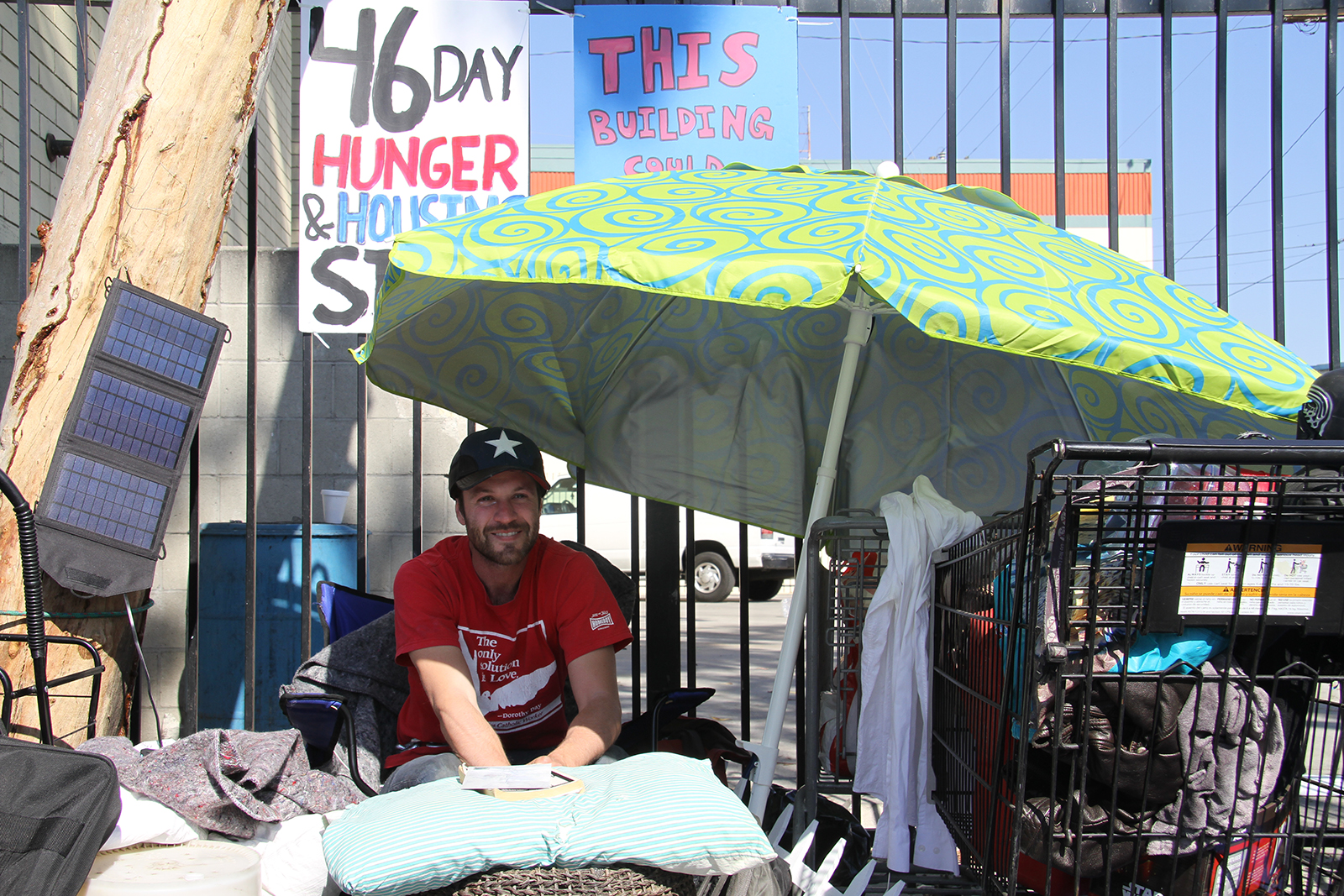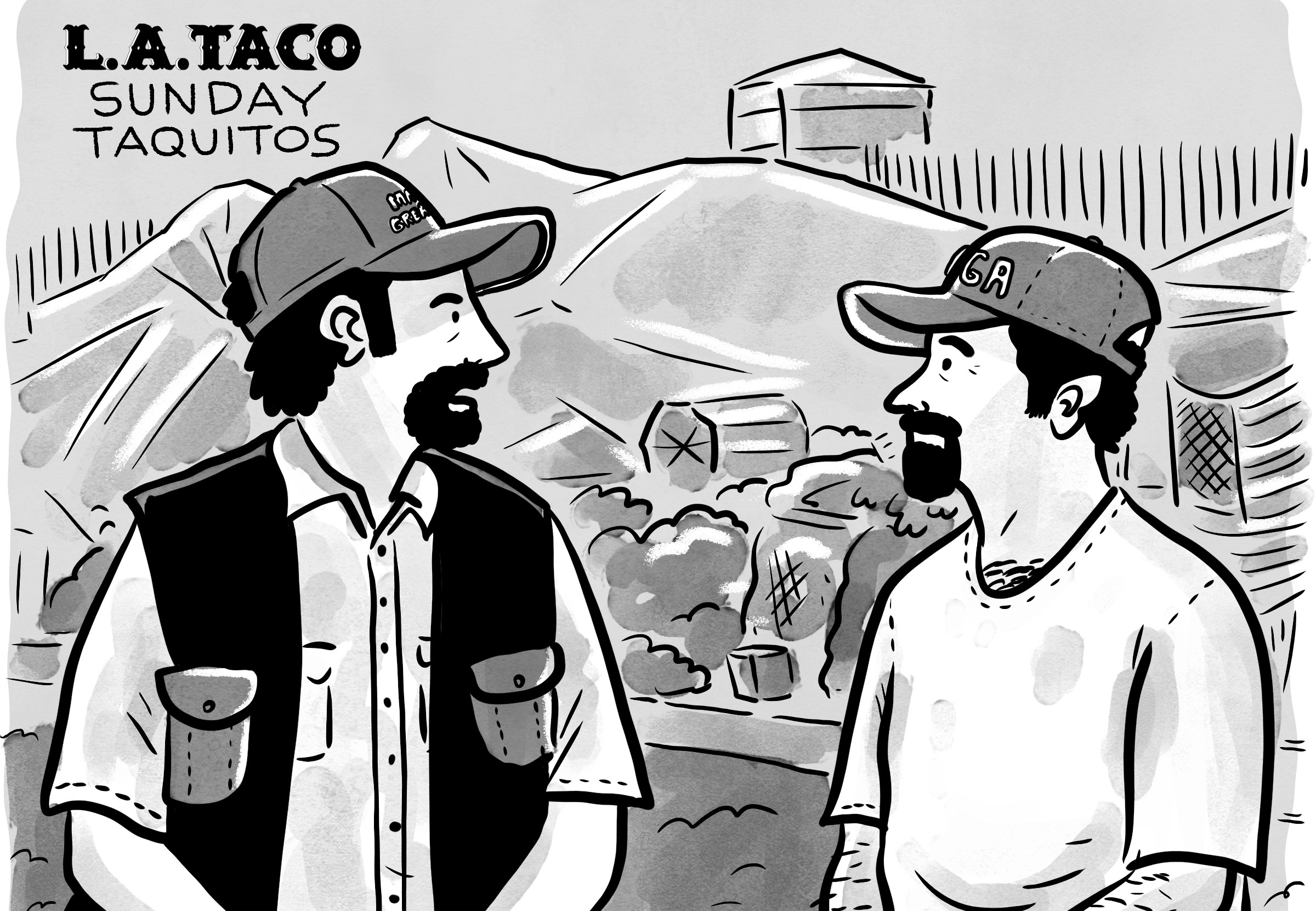[dropcap size=big]F[/dropcap]ed up with the homeless situation in Los Angeles, Kaleb Havens lived chained to a fence on Skid Row between Ash Wednesday in February and Easter last Sunday — a total of 46 days. For 36 of those days, the 30-year-old activist with the Los Angeles Catholic Worker, went on a hunger strike for Lent.
Havens’s act is another symbol of the failure of city, county, and state leaders to effectively address the housing crisis. Los Angeles has more people living in the streets and shelters than any city in the United States, surging 75 percent in the past six years.
Havens chose the 40-day period preceding Easter — a season associated with sacrifice and reflection inspired by Jesus Christ’s withdrawal into the desert — to draw attention to the plight of the homeless in L.A.
“This is the time of year we choose to find compassionate ways to live,” he said.
In this part of L.A., tents and tarps covered every inch of sidewalk down the block, leaving passersby little choice but to walk in the street. The activist’s campsite blended in with the dozens more that crowd the sidewalk of this bleak industrial block of downtown, besides the protest signs with large hand-painted letters that proclaim “46 Day Housing and Hunger Strike” and “Houses Not Handcuffs.”
RELATED: How this POC, Women-Led Group Is Taking a DIY Approach to Feeding South L.A.'s Homeless
Starting on Feb. 14, Havens camped on a patch of sidewalk at Fifth and Gladys, on the eastern end of Skid Row. For 36 days, he subsisted on a diet of bone broth, electrolytes, coconut water, and tea. He had support from advocacy groups with deep roots on Skid Row: the Los Angeles Community Action Network, United Coalition East Prevention Project, and Los Angeles Catholic Worker, which operates a soup kitchen at 6th and Gladys where Havens began volunteering in 2013.
The activist is originally from Indiana. He studied English literature and telecommunications at Indiana University. He described the experience as intense and brutal, saying he saw how the incessant dust and particles from downtown traffic seemed to be aging his skin more quickly.
He also said he made a lot of meaningful friendships. “A lot of steady hardships and pressure making diamonds,” he told L.A. Taco in an interview.
'A lot of steady hardships and pressure making diamonds.'
“We all supported him collectively,” said Eddie H., a long-time homelessness activist with United Coalition East Prevention Project, a community-based alcohol and drug prevention program on Skid Row. “He was never alone.”
To make it more difficult for Los Angeles police or sanitation crews to interrupt the protest, Havens chained himself to the bars of an iron fence at his camp site. He wrapped the chain around his waist, and it gives only a few feet of slack, just enough length for him to manage the small camp. Community activists like Eddie H. supplied Havens with necessities like bottled water and kept him company around the clock.
[dropcap size=big]I[/dropcap] met Havens on the Saturday before Easter, the final day of his protest. He offered me a seat on an overturned milk crate near a small charcoal grill he calls the fireplace. A wood cross as tall as Havens was leaned beside the chair.
He had brought the hunger strike to an end the previous week and was taking solid food again after he had begun having health problems. He seemed relieved the protest was nearly over.
“I was in pain and uncomfortable but not nearly as much as people that have to live whole decades of their lives out here without adequate hygiene services,” he said.
As he talked, Havens scooped soil from a compost over his shoulder and added it to a potted snake plant. He said the objective of the hunger and housing strike was to push city officials to consider policies he feels have potential to heal the neighborhood.
Millions of dollars from recent ballot measures are beginning to flow to fund services and the construction of permanent supportive housing in L.A., but much of it appears to be going nowhere. Havens warned that money alone will not provide housing solutions.
“[The solution] not just creating these social services, but making them humane,” he said.
Havens chose as the location for his protest the sidewalk before a vacant building that was once Salvation Army Harbor Light, a 140-bed shelter for homeless men battling alcoholism and drug addiction on Skid Row. The shelter closed in 2009 and has not reopened.
RELATED: Don't Blame the Homeless for the Skirball Fire, Blame the City
Anti-poverty activists based on Skid Row have set up protest encampments in the past. Los Angeles Community Action Network and allied groups camped on the lawns around City Hall for two months during Occupy Los Angeles in 2011, said General Dogon, an activist with the group. They camped for multiple nights in front of the LAPD Central Division in Skid Row in 2012. But Dogon, who has been an organizer on Skid Row since 2005, couldn’t recall a hunger and housing strike like the one Havens completed.
Eddie H., who has been active in Skid Row for more than 20 years, couldn’t recall one either. “Certainly not one for anywhere near that many days,” he said.
Havens says the city has been lenient on developers who buy land in a derelict neighborhood like Skid Row as an investment, hold it for future use, and make no specific plans for its development. He recommends the city apply a vacancy tax of 1 percent of a building’s assessed value for every year it is declared vacant, to discourage developers from land banking.
He criticized the current vogue among city officials and some advocates for decentralizing homeless services and shelters that for many decades have been concentrated in Skid Row. Havens regards talk of decentralization as a euphemism for what he called “coerced relocation.”
“The worst kind of help moves people to Lancaster,” he says. “You can’t call it help if you’re uprooting them from the community where they’re going to access that help.”
Similarly, he called for catering the rents at new affordable housing units to the median incomes of actual Skid Row residents.
Risking Arrest
By chaining himself to a fence on Skid Row, Havens risked arrest by city police and sanitation workers who sweep the streets and sidewalks of Skid Row. Tension came to a head on March 5, the day of a scheduled street sweep, and the police and street cleaners skipped the block.
Volunteer supporters of Havens cleaned the block instead.
“We decided to be our own Operation Healthy Streets,” said General Dogon, referring to the city’s sanitation program on Skid Row. “We got there a half hour before them, put up plastic tape and had 15 volunteers in Hazmat suits with brooms and rakes and plastic bags.”
Rather than roust Havens, city officials have reached out. Councilmember Jose Huizar, whose downtown district includes Skid Row, visited Havens on Skid Row. Mayor Eric Garcetti called Havens on the phone.
“The Mayor shares Kaleb’s perspective, and respects Kaleb’s First Amendment rights and commitment to the cause,” said Anna Bahr, a spokeswoman for the mayor.
Rick Coca, a spokesman for Councilmember Huizar, said: “The Councilmember wanted Kaleb to know he shares a lot of the same goals. They’re not going to agree on every subject, but there’s a lot of common ground stuff that we’re working on and he also believes in, and we can help each other out.”
Havens reserved his harshest words for the Business Improvement Districts active in downtown.
“They create conditions for others to profit off the land,” he said. “They turn old social services into boutique micro lofts for students. They do all they can to make housing solutions more difficult to enact.”
BIDS, as they are known, are membership groups of land and business owners in a geographically defined area that pay an additional tax to fund special projects within their boundaries, including private security. The Central City East Association is a business improvement district that covers the area where Havens set up camp. Estela Lopez, executive director, did not respond to a request for comment.
Aaron Milsap is a neighbor of Havens’s who has lived at a sidewalk encampment near Fifth and Gladys for more than two years. Milsap, 56, heard about Havens’s protest and went to see for himself.
“I think it’s very noble what he’s doing,” Milsap told L.A. Taco. “I hope it’s bringing insight to the eyes of a lot of politicians in L.A. Of course it could be falling on deaf ears.”
RELATED: Homeless ~ El Segundo







